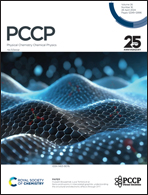Delving into theoretical and computational considerations for accurate calculation of chemical shifts in paramagnetic transition metal systems using quantum chemical methods†
Abstract
The chemical shielding tensor for a paramagnetic system has been derived from the macroscopically observed magnetization using the perturbation theory. An approach to calculate the paramagnetic chemical shifts in transition metal systems based on the spin-only magnetic susceptibility directly evaluated from the ab initio Hilbert space of the electronic Zeeman Hamiltonian has been discussed. Computationally, several advantages are associated with this approach: (a) it includes the state-specific paramagnetic Curie (first-order) and Van Vleck (second-order) contributions of the paramagnetic ion to the paramagnetic chemical shifts; (b) thus it avoids the system-specific modeling and evaluating effectively in terms of the electron paramagnetic resonance (EPR) spin Hamiltonian parameters of the magnetic moment of the paramagnetic ion formulated previously; (c) it can be utilized both in the point-dipole (PD) approximation (in the long-range) and with the quantum chemical (QC) method based the hyperfine tensors (in the short-range). Additionally, we have examined the predictive performance of various density functional theory (DFT) functionals of different families and commonly used core-augmented basis sets for nuclear magnetic resonance (NMR) chemical shifts. A selection of transition metal ion complexes with and without first-order orbital contributions, namely the [M(AcPyOx)3(BPh)]+ complexes of M = Mn2+, Ni2+ and Co2+ ions and CoTp2 complex and their reported NMR chemical shifts are studied from QC methods for illustration.



 Please wait while we load your content...
Please wait while we load your content...